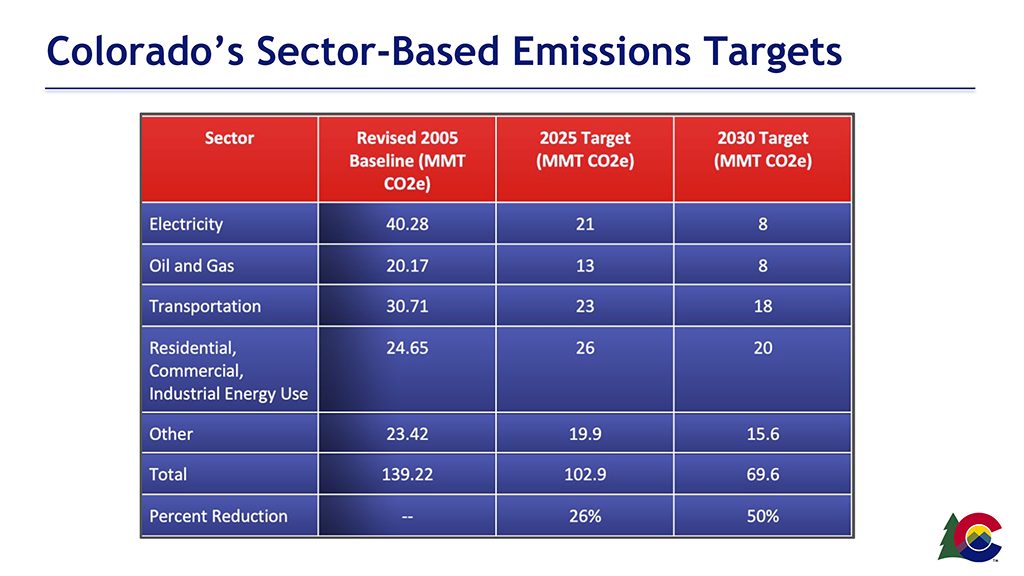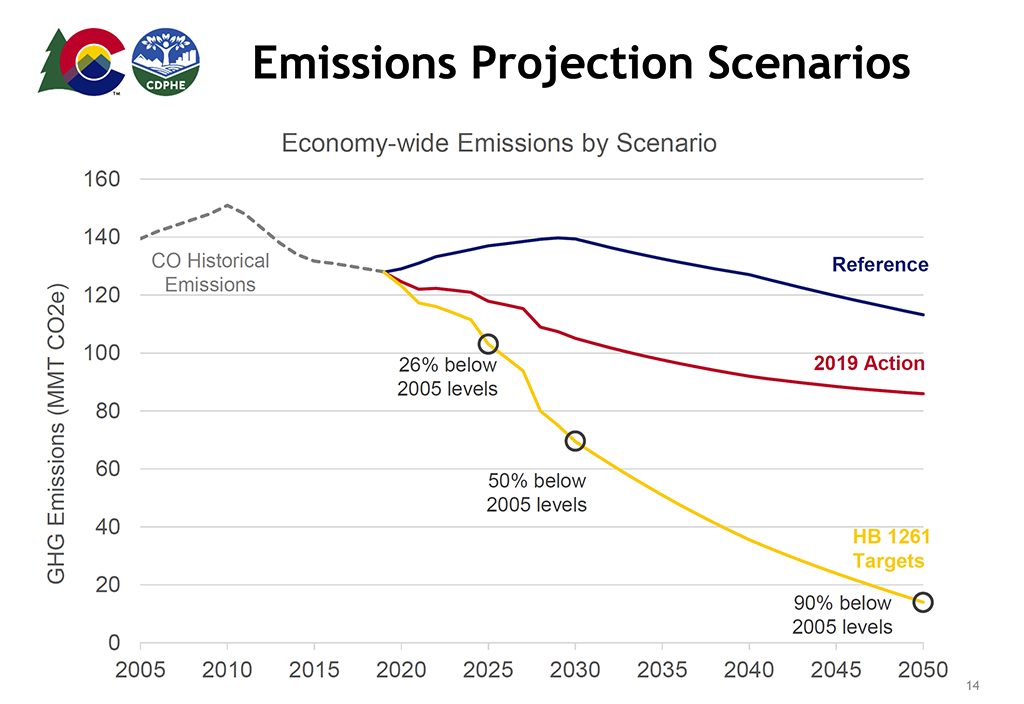Written by Ron Bennett
I haven’t slept well since September 17th… That’s the day my solutions-focused climate optimism ran headlong into the political reality of regulating oil and gas in Colorado. In case you missed the hearing, here is an update on what happened:
Impassioned Testimony
The proceedings opened with a one-hour public comment period. Those that testified were united in their frustration with the commission for not moving faster to reduce emissions from the oil and gas sector. Poor air quality, specifically high ozone levels along the front range were of great concern. The disproportionate impact to front-line communities was cited together with a lack of representation for these communities in the rule-making process. One witness pointed out that going for a run outside is a privilege and many who work outdoors have no choice but to frequently expose themselves to unhealthy air.
Many witnesses were critical of APCD’s proposed GHG intensity target rule. They urged the commission to instead address the region’s severe non-attainment of federal clean air standards for ozone. Many called for direct regulation of the oil and gas industry with clear consequences for violators including shutting down non-compliant operations and denying new permits.
Additionally, the day before the hearing, 350 Colorado, partners, and more than 50 activists gathered for a press conference calling on the AQCC and the Polis administration to take immediate action on climate change.
Intensity Target Rule
One of the main agenda items for this hearing was a request by the Air Pollution Control Division (APCD) for a hearing on a proposed intensity target rule to establish oil and gas reduction strategies, monitoring, record keeping and reporting in response to two-year-old legislation.
Criticism of the proposed intensity target rule stems from its reliance on self-reported or non-existent data with only periodic emissions sampling to verify intensity factors. These factors are to be applied to fossil fuel production per equivalent barrel of oil to determine an operator’s emissions. This labyrinthine accounting not only leaves many opportunities to game the system but also has the perverse effect of reducing an operator’s intensity factor when production is increased since intensity is calculated by dividing emissions by production.
Deep emissions reductions are supposed to come from plans submitted by operators that will form the basis of a 2024 regulatory package, five years after the state legislature mandated such reductions.
Commissioners noted a difference in proposed intensity targets for small vs. large operators. As currently proposed, small operators would be allowed three times the emissions intensity of large operators. Acknowledging both written and oral testimony in opposition to the intensity program commissioners questioned division staff but ultimately voted to set a hearing to consider the program. Some attributed concern and confusion expressed in testimony to the program’s complexity and a lack of communication with stakeholders.
Large Hydrocarbon Emission Events
APCD staff also indicated that the development of the intensity program included data derived from aerial surveys conducted in July. Presumably, these surveys detected levels of pollution that would qualify as super-emitters, but the division prefers to rebrand these as a “large hydrocarbon emission event.” For reference, NASA has performed methane emission aerial surveys over the Permian basin, defining super-emitters as sources emitting more than 22 pounds per hour. Researchers concluded that repairing only 123 of these sources could reduce emissions from the Permian by 50 metric tons per hour.
An Historic Legislative Session
Skipping ahead to CEO Executive Director Will Toor’s lengthy presentation on progress toward achieving targets in Colorado’s GHG Emission Reduction Roadmap. Director Toor reviewed 2021 clean energy and climate legislation. These include funding for environmental justice, a just energy transition and transportation planning. A group of bills targeting the building sector include funding to promote energy efficiency and electrification.
Citing progress in the electricity sector and better than expected electric vehicle adoption in Colorado, Director Toor optimistically stated that we are well on track to meet climate targets.
Projected GHG reductions across the building, energy and transportation sectors rely on plans developed by investor-owned utilities and approved by the Public Utilities Commission (PUC). For example, HB21-264 sets targets for GHG reductions for gas utilities of 4% by 2025 and 22% by 2030. The bill is technology neutral, meaning gas utilities may meet these targets by any means that is financially viable, including methane recovery from coal mines, hydrogen production and carbon capture and sequestration. 350 Colorado opposed this bill as it will only delay the inevitable transition to 100% renewable energy.
At the conclusion of the CEO’s presentation, one commissioner thanked the director and indicated that his presentation answered critics that say we won’t hit 2025 targets. Another commissioner noted that a bad ozone season because of particulates (a reference to wildfire smoke) does not indicate AQCC inaction.
Industry Writes the Rules
Many of the CEO’s GHG reduction projections are dependent on plans proposed by for-profit entities that become the basis of rules adopted by governor-appointed commissions. Addressing ground-level ozone isn’t a priority for oil & gas operators or public utilities. With an Air Pollution Control Division that refers to regulated sources as “customers” and the Polis administration and its appointees blaming western wildfires for poor air quality, I wonder how and when the region’s severe non-attainment of federal clean air standards will be addressed.
A recent report from the Colorado Attorney General’s office in response to a whistleblower complaint at the APCD has substantiated claims that air quality permits were issued despite modeling indicating emissions exceeding federal limits. These emissions – nitrogen dioxide, sulfur dioxide and PM 2.5 – contribute to ground level ozone.
Further, a CSU study noted that most high-ozone days were “not impacted by wildfire smoke.” Yet officials consistently focus on wildfire smoke as the cause.
Unlike wildfire smoke, pollution from vehicles is a major source of ground-level ozone. The Employee Traffic Reduction Program (ETRP) would have reduced both GHG emissions and harmful ozone. After a year-long rule-making process and intense opposition from business groups the AQCC voted in August to withdraw the rule with little explanation.
Opinion
It worries me that agencies charged with protecting public health are so cozy with the industries they regulate while dismissing public outcry and federal air quality standards. The intensity target rule has been embraced by oil and gas so that should worry you too. Employing complex modeling instead of directly measuring emissions or considering their cumulative effects is irresponsible.
Observing these proceedings leaves me with the impression of an elaborate ruse designed to demonstrate progress on climate and health while perpetuating business as usual. Why not release aerial methane survey data and focus on super-emitters today instead of waiting until 2024?
The Polis administration’s policies allowing the expansion of oil & gas development during a climate emergency is counterintuitive and completely ignores the climate impacts of exported fossil fuels. These ‘scope 3’ emissions equal 120% of in-state GHG emissions and should be considered in the roadmap.
I urge you to join me in support of 350 Colorado’s call to phase-out fossil fuel extraction in Colorado by 2030. Shepherding the state toward a carbon-free future will take immense political pressure and many voices like mine and yours.


